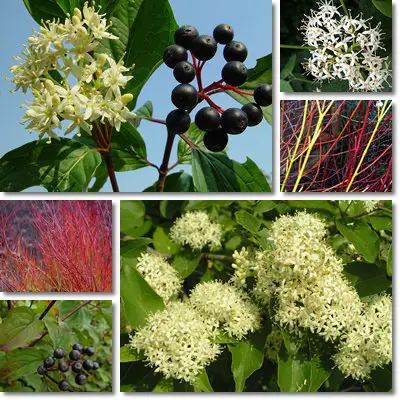The common dogwood (Cornus sanguinea) is one of many species in the dogwood family having several impressive medicinal properties. The species is used extensively in herbal medicine for the purpose of stimulating digestion, as a natural antipyretic or fever reducing agent as well as for inducing vomiting. However, various parts of the plant contain several compounds with potentially harmful side effects which is why precaution is required when taking common dogwood preparations.
About common dogwood
What does common dogwood look like and where can it be found? The common dogwood is a shrub primarily grown for ornamental purposes. It can reach heights of around 5-6 meters and can be found throughout Europe, Western Asia and the temperate regions of the American continent, both in gardens and in the wild, at forest edges, on river banks and so on. The species has elongated, oval green leaves, slightly lighter below and dark green-brown branches which lose their foliage in the cold season.

The reason why the common dogwood is a preferred garden plant is because its branches turn yellow-orange with red tips in winter, a rather unusual coloring for any leafless plant during the cold season. Such varieties are called ‘winter fire’. The tiny four-petaled cream-colored flowers have four upright stamens and are disposed as a cross. They grow in small clusters and leave room for single-seeded dark-blue round berries later on. The fruits of the common dogwood also grow in clusters and are known as ‘dogberries’. They represent an essential food source for numerous bird species.
Can you eat common dogwood berries?
Are common dogwood berries edible or toxic? What do common dogwood berries taste like? Apparently, common dogwood berries are not toxic (poisonous), however, they are not very palatable either and have a rather high tannin content which renders them inedible in raw form. Tannins are bitter and astringent plant compounds which make fruit such as dogberries too tart for consumption. Cooked dogberries however are said to be edible.

What is common dogwood good for?
The berries and bark of the common dogwood bear great medicinal value and have been long recognized as potent herbal treatments for various conditions. Find out below what are the 4 main uses of common dogwood preparations:
Natural antipyretic
It would appear that preparations made from the berries and bark of the common dogwood boast rather impressive antipyretic properties, helping reduce fever naturally. However, for safety reasons, it is important to avoid making your own dogwood preparations because dogwood species look a lot alike and it’s extremely easy to mistake a tree variety that is safe for use with one that is toxic. It is recommended to ask the advice of an expert or, even better, get your dogwood preparation from a health food store, pharmacy etc.
Digestion aid
Common dogwood preparations may help improve digestion. Traditional medical practices recommend eating a small amount of fruit for a better digestion. Eating too many may result in an upset stomach and other unpleasant gastrointestinal problems.
Natural emetic
Common dogwood preparations have also been used as a natural emetic, to induce vomiting. The purpose for this was to help clear the contents of one’s stomach and expel potentially harmful foods (toxic or poisonous foods). However, considering the evolution of medicine, it might be wise to address a medical professional if you suspect having consumed contaminated or improperly stored food.
Antimicrobial and hepatoprotective
Common dogwood berries have been found to have antimicrobial, anti-inflammatory, hepatoprotective and wound healing properties. Aucubin, a compound found in dogberries, possesses several great medicinal properties. When consumed in small amounts, common dogwood berries or preparations exhibit antimicrobial activity, support liver health, reduce inflammation and promote wound healing of mouth lesions especially.
Side effects and safety
Nevertheless, all dogwood preparations (dogwood, common dogwood, American dogwood and Jamaican dogwood) should be taken under the careful supervision of a medical professional because of the health risks that may arise from ingesting too much berries, decoctions, tincture etc. For example, common dogwood leaves, bark, twigs and roots contain aucubin, an iridoid glycoside, as well as tannins. These two compounds can cause gastrointestinal problems (abdominal discomfort, nausea, vomiting) or skin and stomach irritation when moderately large amounts of berries or plant preparations are consumed.
Conclusion
Overall, when it comes to dogwood and its use for health purposes, it might be wise to check with your doctor first about safety, possible interactions and recommended intake and maintain constant contact throughout your treatment period. Get your dogwood preparations from a pharmacy or a store specialized in natural preparations from medicinal plants. Remember that some dogwood species are toxic. Also, limit intake to amounts recommended by your doctor in order to avoid any possible complications or side effects.
